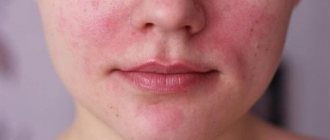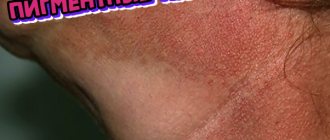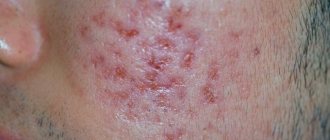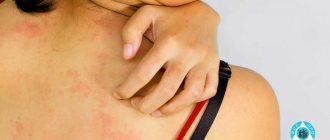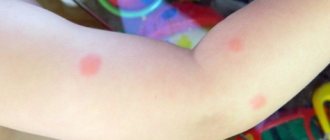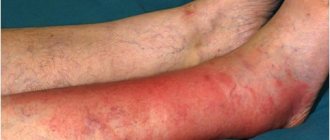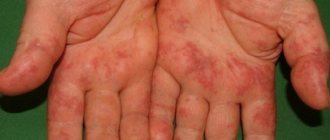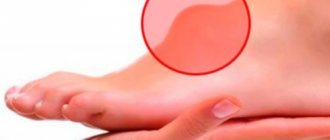Allergy disease takes on various forms, affecting people of different ages and localized in any part of the body. Lesions on sensitive areas of the skin are especially common, for example, allergies on the neck.
A rash on the neck causes a lot of negative sensations and cosmetic discomfort. In addition, as a result of the addition of secondary infections, various complications arise that are much more difficult to neutralize. Therefore, timely identification of allergens and correctly initiated treatment therapy are very important.
A red spot appeared on the neck - types
The spots can appear on almost all parts of the neck, including the neck. Immediately after a change in skin color, you should think about the need to visit a specialist.
This is due to the fact that often spots on the skin indicate other more serious diseases or are the body’s reaction to infection.
Based on visual characteristics, the following classification features are distinguished:
- Tactile sensations.
- Pigmentation.
- Other additional symptoms.
In some cases, changes in the skin can be determined not only visually, but also by touch.
Based on tactile sensations, the following options are distinguished:
- Speakers.
- Rough.
- Smooth.
In almost all cases, a change in color occurs. In this case, the spot can be light or dark.
As for additional symptoms, they may be as follows:
- The passage of inflammatory processes.
- The appearance of peeling.
- The spot may be itchy or itchy.
In addition, experts also identify a number of visual distinctive features, according to which the following classification was carried out:
- Strong pigmentation. This category includes cases where the skin changes color from white to brown. In most cases, the reason for this change is the lack of the required amount of melanin.
- Vascular in nature. Such spots can range in color from pink to purple, in most cases the shades are bright. The cause of such changes in most cases is problems with the vascular system.
- Artificial. They are characterized by the fact that they are formed as a result of the introduction of various substances artificially into the subcutaneous layer. An example is common tattoos.
Let's celebrate! In many cases, spots indicate the appearance of a serious disease or the body’s response when exposed to an external irritant.
Symptoms
The clinical picture will depend on the cause of this symptom. In case of an allergic reaction, redness may be accompanied by the following symptom complex:
- itching, which can occur both at rest and when scratching;
- rashes in the neck, back of the head, and sometimes back;
- general malaise;
If the cause of this symptom is a fungal disease, then the clinical picture can be characterized as follows:
- in the area of redness, flaky spots may appear, with the formation of bubbles with liquid;
- severe itching and burning;
- spots can transform into plaques, papules, erosions;
- itching may be present not only in the area of redness, but also in other areas of the body.
Redness of the neck in men or women may be a manifestation of thyroid disease, which will be accompanied by the following symptoms:
- itching on the front of the neck;
- inflammation of the cervical and submandibular lymph nodes;
- increase in goiter;
- periodic
Redness on the neck may be a sign of neurodermatitis. In this case, the clinical picture will be characterized as follows:
- severe itching, which only intensifies when scratching;
- a rash that later forms into plaques and blisters with fluid;
- rashes can be grouped together;
- formation of crusts at the site of the rash.
For any type of manifestation of the clinical picture, you should seek help from a doctor rather than try to eliminate the symptom yourself. The use of local remedies can eliminate the symptoms, but not the provoking factor itself. This means that a relapse of the disease or the development of complications can occur at any time.
Red spot on the neck of an adult
In adults and children, diseases and allergic reactions occur differently. In adults, spots on the neck can be localized or cover the entire surface.
Based on external main features, several main groups can be distinguished:
- According to the degree of convexity.
- Weeping or dry redness.
- The occurrence or absence of an inflammatory process.
- Clear display of boundaries or lack thereof.
- The presence of a scaly growth or its absence.
Good to know! In adults, in most cases, spots appear due to disruption of important body systems, which may be associated with the development of serious pathologies. Moreover, the degree of manifestation of symptoms in each case is individual.
Photo
Photo
Etiology
If we talk about redness of the skin on the neck as a result of certain diseases, we should highlight the following:
- allergic reactions;
- fungal diseases;
In addition to pathological processes, external irritants can provoke redness on the neck of an adult or child:
- scratching insect bites;
- prolonged exposure to the sun;
- increased susceptibility to ultraviolet rays;
- reaction to metals or fabric;
- , nervous tension.
Redness on the neck of a baby may be a manifestation of hormonal changes, which is not a disease. In such cases, redness disappears on its own within the first month. In addition, such a manifestation may be a sign of food allergy or infection in newborns, so consultation with a doctor is required.
Even if red spots on the neck and back of the head do not cause concern, you should still seek the advice of a doctor and not self-medicate or completely ignore the symptom.
In what cases does the red spot on the neck itch?
The spots may amount to a rash. At the same time, they can change their symptoms and cause itching.
Typically, the following symptoms change:
- Density.
- Relief.
- Coloring.
- Papule.
- Blister formation.
Redness that itches may indicate the following signs:
- Development of dermatitis.
- Disruption of the autonomic system.
- Manifestation of an allergic reaction.
- Development of photodermatosis.
- The appearance of an infectious agent.
- Development of psoriasis.
Good to know! If the symptom in question manifests itself, experts recommend that you consult a specialist.
Causes of red spots on the neck
Experts identify a specific list of reasons that can lead to the appearance of the symptom in question.
The most common are:
- Various insect bites. When they bite, they can inject various toxins, which cause long-term irritation.
- Allergic reaction. It appears after direct contact with the allergen.
- Hives also refer to an allergic reaction to an irritant.
- Infectious diseases. There are quite a few of them, in most cases the body’s response is a strong increase in temperature.
- Autoimmune processes. The most common disease is lupus erythematosus. As a rule, in such a case, the redness has clear boundaries, and other common symptoms also clearly appear.
- Stress. Strong emotions and worries can also cause changes in color and other signs of the skin. It is worth considering that only a certain group of people have a similar reaction to stress. Only a specialist can make an appropriate diagnosis, since not everyone can determine their stressful state. The treatment is quite simple, but it takes quite a long time to achieve the desired result.
Note! It is quite difficult to independently determine the causes of the manifestation of the symptoms in question; only by collecting an anamnesis and obtaining test results can a specialist make the correct diagnosis.
Treatment
In most cases, treatment is complex and limited to conservative methods of therapy.
In this case, treatment with traditional medicine is not excluded, but their use should be carried out only after agreement with the attending physician and as a supplement to the main course of therapy.
The medicinal part of treatment may include the following drugs:
- non-steroidal anti-inflammatory drugs;
- antihistamines;
- antibiotics;
- antipyretic.
If the disease is diagnosed in infants or pregnant women, oral drug treatment is reduced to a minimum. It should be noted that to eliminate the symptoms themselves, not only oral, but also local medications can be prescribed.
As an addition to the main course of treatment, the doctor may prescribe physiotherapeutic procedures and special dietary nutrition.
In general, if therapy is started in a timely manner and the underlying factor is not an autoimmune pathological process, the prognosis is favorable and no significant complications are observed.
Treatment tactics
In order to cure allergic irritation on the chest and neck, it is necessary to identify the substance that caused the rash on the neck, interrupting interaction with it.
To prescribe adequate treatment, an integrated approach with preliminary consultation with a specialist and a diagnostic examination is recommended. Almost any allergic reaction requires oral administration of long-acting antihistamines with minimal side effects (Claritin, Zyrtec, etc.).
Local irritation in the neck area can be effectively treated with anti-inflammatory ointments, gels, and creams. The most commonly used are water-based emollient creams and ointments, which are applied in a thick layer and rubbed until completely absorbed into the skin. Such external products moisturize the skin well, relieve itching, prevent scratching and relieve skin irritation.
If the situation worsens, when irritation is not relieved by simple hypoallergenic ointments and causes arise for the possible development of skin dermatitis or eczema. In this case, it is recommended to use external steroid agents. However, a cautious approach to such treatment is recommended. Taking into account all the reasons for the development of allergies in an adult patient and a child, an individual dosage is selected.
Hygiene measures are of great importance. Regularly taking a warm bath reduces itching, relieves skin irritation in the baby, and eliminates discomfort in the neck and shoulders.
In addition, treatment requires adherence to a special diet, excluding highly allergenic foods.
Minor rashes and redness can be effectively treated using traditional medicine recipes if you regularly make lotions with medicinal herbs (sage, chamomile, nettle, celandine, etc.). However, before using traditional methods in an adult patient or a child, it is recommended to first consult with your doctor in order to prevent an exacerbation of the allergy when the rash spreads to the face, cheeks, and ears.
For preventive purposes, it is necessary to strengthen the immune system, because the weakening of the body’s defenses provokes allergic irritation. It should be noted that at present, allergies cannot be cured completely, but an acute allergic reaction is effectively neutralized with complex treatment.
Redness of the neck - hyperemia of the skin in the neck area, affecting the occipital region and chest. Such a symptom can be a consequence of both certain diseases and a reaction to external stimuli.
Treatment is prescribed only by a doctor, after carrying out all the necessary diagnostic measures in a given clinical case. Self-medication can lead to complications.
Recipes from folk sources
Treatment will be more effective if you combine traditional methods of treatment with folk ones, but this must be agreed with your doctor. Traditional medicine recommends:
- treat a red spot on the neck that itches with calendula infusion;
- lubricate the affected areas with iodine solution;
- apply lotions made from apple cider vinegar and mustard powder;
- apply a cabbage leaf coated with sour cream to the rash;
- drink a decoction of nettles;
- wipe areas of skin with a rash with lemon juice, but only if they are not irritated;
- apply grated carrots, it improves the condition of the skin;
- make a mask from chopped parsley;
- Lubricate affected areas with sour cream.
A positive effect is observed from the use of:
- Lotions prepared on the basis of infusion of birch buds. It is recommended to pour 1 tbsp. l. kidneys 250 ml. boiling water and leave for several hours. Strain and apply to the affected area for a quarter of an hour.
- Oatmeal scrub. To prepare, you need to mix oatmeal, milk and blue clay in equal quantities. Apply the resulting mixture to the stains and leave for 15 minutes, then rinse with water.
- Infusion of nettle, celandine and yarrow.
Other diseases
If there are red and itchy spots on the neck under the hair, they may indicate psoriasis or eczema. The affected area may experience itching, burning and other imperfections. If we talk about treatment, there is no specific remedy; the only thing a doctor can recommend is hormonal drugs. There are also other problems accompanied by the appearance of red spots on the neck, we will consider them below.
Return to contents
Red spots appeared on the neck and itched photo
Hemangioma
Those spots that are very dark in color, or rather even burgundy, and they look like moles, then most likely they are hemangiomas. They are of a benign nature and do not pose any danger to humans. In some cases, formations can make themselves felt, but only if they suddenly begin to increase in size. In this case, it is better not to put off visiting a doctor until later, as this most likely indicates their degeneration into oncology.
Infectious diseases
Red spots appeared on the neck - perhaps this is a symptom of an infectious disease. They can occur with diseases such as chickenpox, scarlet fever, measles, etc. When they appear, other symptoms may be observed - body temperature rises, general malaise, nasal congestion, sore throat, etc. You should not self-medicate; it can be extremely dangerous; if such symptoms occur, you should consult a doctor. Moreover, it is recommended to call a doctor at home, because you will be potentially dangerous to others.
Dangerous accompanying symptoms
Local changes in skin color and itching are not the only troubles with diseases. Due to its dermatological nature, the red spot on the neck itches and peels off, the rash spreads to the scalp, and exudate (liquid when the pimple is damaged) may appear. In severe cases, the temperature rises, weakness and dizziness appear.
The same symptoms indicate an allergy, the only difference is the shorter duration of discomfort if the source is eliminated in time.
In autoimmune diseases, the condition worsens due to fluctuations in blood pressure, high fever, and itching. With eczema, red spots turn into blisters if the pathology progresses.
The situation is even more complicated with infections. Associated symptoms of red spots on the neck are:
- migraine;
- a sore throat;
- fatigue;
- increased sweating;
- cough;
- drowsiness;
- tearfulness;
- nausea, vomiting;
- heat;
- rash all over the body;
- sluggish state.
In women, the frequency of menstruation is disrupted, and in men, potency decreases.
Clinical signs of lichen varieties
In addition to the main general symptom, each disease has accompanying symptoms, which can be used to preliminarily suspect a diagnosis.
Varieties of the disease differ in etiology, individual tolerance of a particular patient, and associated symptoms.
Pythiasis, red variety
The pink species differs from the other two species in its seasonal appearance. Children are rarely affected, mainly after vaccination. The initial stage of pithiasis - one large white spot is formed, which at first is pink only at the edges, then the lesion acquires a pinkish tint.
The primary localization is the chest, then the rash progresses to the shoulders and abdomen. Almost never found on the face. Children may suffer from body hyperthermia and general weakness. After recovery, the skin at the site of the lesion darkens.
The red variety is divided into three forms of flow, but only the ring-shaped form forms a round spot on the skin with a red rim. At first it is a small red lesion, the center quickly heals and turns white - what remains is a white center and a red ring, which is where the name of the form comes from. Men are most often affected by the disease.
In this case, the location of the papules is the genitals. Associated symptoms are periodic increases in temperature, not only the sore spot itches, but the whole body. Possible sites of localization include the oral mucosa.
Shingles
The origin of the disease is herpes virus. Duration - more than twenty days. Less common is a mild form – ten days. Accompanied by severe pain. An even rarer form is asymptomatic, which does not require therapy. The virus can survive in the body for a long time and “wake up” during a period of weakened immunity.
Associated symptoms are severe itching, fever during exacerbations, weakness. The rash may not go away for several months, sometimes remaining for two or three years. Elderly people - after fifty years - are susceptible to infection. Relapses are possible. If children become infected with the virus, the disease occurs in the form of typical chickenpox.
Atopic dermatitis
The spot on the neck is red, itchy and painful - most likely it is Atopic dermatitis. Unfortunately, this is a chronic disease that simply cannot be cured. During the period of exacerbation, such formations will begin to peel and itch severely. All this will cause severe discomfort to the patient.
In order to somehow alleviate the patient's condition, doctors can prescribe ointments with a cooling effect. The patient, in turn, must reduce contact with the allergen to a minimum.
A bite of an insect
Even after you have been bitten by mosquitoes, you will notice that spots begin to appear on your neck. If such affected areas are accompanied by itching, they can be treated with a special ointment that will help relieve the itching; you can buy it at any pharmacy. If severe swelling occurs, you will have to visit a medical facility.
Clinical picture
Symptoms of the pathological condition will depend on the provoking factor that the neck turns red and itches.
With psychomotor disorders, redness appears on the neck; it practically does not bring any pathological sensations; in rare cases, itching may occur.
If spots on the neck appeared due to diseases of a dermatological nature, then their characteristic features are that they:
- spread to the scalp and upper extremities;
- may change, fill with exudate and peel off;
- lead to itching.
In severe cases of the disease, an increase in body temperature and a deterioration in the general condition of the person may be observed.
If the cause of the spots on the neck is an allergy, then the symptoms will be almost identical to the previous case, the only difference will be the duration of their presence and severity.
In diseases of infectious origin the following will be observed:
- irritation on the neck;
- increased body temperature;
- headache;
- fatigue;
- a sore throat;
- cough;
- hyperhidrosis;
- production of excessive tears;
- rash over the entire body;
- clinical picture of intoxication of the body.
The following picture will be typical for autoimmune disorders:
- a red spot appears on the neck, which itches and flakes;
- deterioration of general condition;
- feeling of general weakness;
- increased body temperature;
- blood pressure surges;
- itching
Eczema is characterized by the formation of red spots, which, as the pathological process progresses, turn into blisters. There is a feeling of unbearable itching and peeling.
Redness on the neck in women can be accompanied by disruptions in the menstrual cycle and hormonal imbalances. Representatives of the stronger half of humanity may experience a decrease in libido and impaired potency.
If red spots appear on the neck, in any situation, you must seek medical help. It is unacceptable to start treatment on your own at home.
Factors provoking the disease
Rashes on the neck occur for a number of specific reasons. The most common causes of allergic symptoms are the following factors:
- use of low-quality cosmetics;
- negative environmental situation;
- A rash on the neck and chest may appear (especially in women) upon contact with jewelry made from precious or simple metals. In this case, redness of the skin is caused by prolonged wearing of jewelry, when, when interacting with the body, the metal undergoes oxidation processes. In this regard, severe itching and a small rash appear;
- use of medicated gel and ointment in the cervical area;
- violation of the diet (especially in a child), expressed by the consumption of highly allergenic foods, as well as the presence of chemicals in them (dyes, preservatives);
- allergies on the neck and chest can occur as a result of exposure to washing powders. Washed items (especially underwear) come into direct contact with the delicate areas of the skin on the neck, provoking an acute allergic reaction;
- the causes of allergic rashes in infants may be a complication caused by indolent heat rash, since prolonged exposure to sweat results in itching and a small rash;
- in addition, an allergic reaction can occur to flowering plants and upon contact with animals;
- Especially often, irritation on the neck can occur in a child due to pet hair;
- the causes of rashes may depend on the individual reaction to synthetic fabrics in direct contact with the neck area (shirts, sweaters, scarves, etc.);
- A rash on the neck is possible as a result of exposure to pathogenic microorganisms and viruses.
The skin of infants is especially sensitive to allergies, since their neck is characterized by the formation of a skin fold, which, when the child overheats or as a result of exposure to sweat, leads to similar symptoms.
Therapeutic measures
If red spots appear on the neck, treatment is carried out conservatively using traditional and folk methods. Prescribed:
- NSAIDs;
- antiallergic drugs;
- antibacterial drugs;
- antipyretics;
- sorbents.
In addition, topical medications, physiotherapeutic procedures, and diet are also used. Most often this is:
- zinc ointment;
- tetracycline ointment;
- tar soap;
- ointments made on the basis of glucocorticoids.
Spots on the neck itch: disease
In most cases, getting rid of discomfort caused by external factors is not difficult. The problem is much more serious if a person gets sick.
Dermatitis
This is one of the main reasons why red spots appear on the neck and itch. Dermatitis develops against the background of stress, poor nutrition, allergies, burns or frostbite of the skin, and problems with the digestive system.
Allergy
A small pink rash covers large areas of the neck and chest, and watery blisters may subsequently appear. Allergies are provoked by:
- external factors: caring cosmetics, jewelry, clothing, perfume, tap water, animal hair;
- internal factors: drinks, food, medicines, dietary supplements, preservatives.
Infectious diseases
At the initial stage, small spots usually appear, ranging in color from pale pink to red-brown. Visual symptoms of the most common infectious diseases can be compared using photos on the Internet.
- Chicken pox. Small red watery pimples are noticeable all over the body. A person with a weakened immune system may get sick a second time. If an adult has red spots all over the body, including on the neck, which itch and fill with watery fluid, this means that the virus has reached the nerve and skin cells. The duration of this stage is 5-7 days.
- Rubella. Pink, oval-shaped spots appear and the lymph nodes become enlarged. A person who has recovered from the disease develops immunity.
- Measles. Small red spots are localized on the neck, scalp, and behind the ears. At the same time, the voice is hoarse and a “barking” cough is tormenting. The infection is very difficult for children and adults to carry. To reduce the risk of disease, vaccination is done in 2 stages.
- Scarlet fever. A profuse rash appears all over the body and at the same time a severe sore throat, and the temperature rises.
Scleroderma
At the initial stage of the disease, a red spot appears. Over time, the skin becomes rougher and swelling appears. In severe cases, the ability to move the neck is limited.
Lichen
A serious skin disease that affects people of any age. There are several forms of lichen; its causative agents are fungi or viruses. The disease manifests itself as red plaques with a white border or pink spots with a yellowish core. It takes a long time to treat lichen, undergoing complex therapy. Most often, the manifestation is visible throughout the body, including the neck.
Psoriasis
The disease can be hereditary or develop against the background of prolonged stress or allergies. Psoriasis manifests itself as flaky red plaques behind the ears, on the neck, scalp, on the bends of the elbows and knees.
Photodermatosis
During irradiation, at first the red spot on the neck does not itch or flake off, but after 5-7 hours or the next day, swelling and the appearance of a small rash and severe itching are possible.
Symptoms and causes of skin spots
A change in color in a particular area of the skin may indicate hemorrhages, chronic diseases, or infections. They also appear when exposed to external factors: allergies, burns, prickly heat, diaper rash. The color of the macula is determined by the level of melanin: brown and black ones have the most of it, white formations lack melanin, red spots appear on the body during inflammatory processes. Also, by the appearance of the exanthema, one can assume its nature and cause of origin.
White spots
Content:
- Symptoms and causes of skin spots
- Treatment and diagnosis
Like all other types of rashes, white macules on the body appear suddenly and can cover large areas of the skin. Spots with a white or transparent tint indicate hormonal imbalance, infection or chronic pathologies. In appearance, there are formations that resemble a birthmark, only lighter. Such an exanthema never protrudes above the surface of the skin, does not crust over, or itch. In this case, the cause may be vitiligo, a hereditary disease that is not life-threatening, but also cannot be cured. Similar symptoms occur with leukoderma, a disorder of pigment production. There are syphilitic and false leucoderma. The first is treated with drugs for internal and external use (only under the supervision of a doctor). The false one appears and disappears on its own, and is most often localized on the neck and chest.
A rash in the form of white spots with a rough surface appears with pityriasis versicolor. In this case, the exanthema first looks like white formations, and over time it can turn into the form of red macules. The rashes often flake and itch and appear on any part of the body. Requires treatment, as lichen is easily transmitted through contact. Also, colorless formations with a red rim indicate dry skin, lack of vitamins and minerals. They appear more often on the shoulders, outer thighs, wrists, and under the breasts.
Red spots
Often redness does not threaten the patient; it passes quickly and without a trace. This happens when in contact with nettles or poison ivy, minor burns, or allergies. The most harmless cause of stains is insect bites. They are easy to distinguish from all other types of exanthema, since they are single, itchy and protrude slightly above the surface of the skin. The cause of such spots is easily traced, and no special treatment is required in this case.
In some cases, red spots on the arms, legs, or torso may indicate a more serious problem. Most often, such exanthema appears when:
- Infectious diseases. Scarlet fever, rubella, measles, and chickenpox are recognized by their characteristic rash. As a rule, in such cases, spots appear simultaneously with an increase in temperature and general malaise. The rash progresses rapidly, covering the face, neck, limbs and torso. The spots in such diseases are small in size and sometimes cover a large area of the body. The rash can turn into blisters or pustules if you scratch them.
- Allergies are the most common cause of blotchy rashes. Appears on the palms and fingers upon contact with an allergen. Also, if you are allergic to the material, spots can cover the entire body. Food allergies are often characterized by a rash on the neck, face, and chest. Along with exanthema, concomitant symptoms of the disease may appear: sneezing, coughing, lacrimation, runny nose.
- Eczema. Pinkish or red areas appear on the body that are very itchy and painful. Over time, crusts and blisters from itching form in place of the macules. This disease must be diagnosed and treated.
- Depriving. A characteristic feature of lichen is the rash itself: it occupies a separate area of the skin without spreading throughout the body. At the same time, lichen, like other infections, can occur against a background of fever and general malaise.
- Hemangioma is a benign formation. May be pink, red or purple. Localized on the face: at the wings of the nose, on the eyelids, near the ears, near the mouth. This disease can be congenital, but manifests itself at different ages. Removed with laser.
- Psoriasis. A disease in which recurrent exanthema forms; the spots are often covered with a light crust. The rash appears due to stress, alcohol consumption, infections, etc. In the absence of treatment, it can go away on its own, but in conditions of poor hygiene and a low standard of living it progresses.
- Stress. In sensitive people, individual red macules may appear in stressful situations, in moments of anger or fear. More often, this phenomenon occurs in people with disorders of the autonomic nervous system. They do not require special treatment and go away during a period of calm.
- Diaper rash. It is also a safe phenomenon, which is more common in young children on the legs, genitals, buttocks, and armpits. Bright scarlet spots are formed from high temperature and sweating and do not require special treatment. To eliminate the symptoms of formation, you need to treat it with talcum powder and maintain hygiene.
Any of these diseases manifests itself in both adults and children. In pregnant women, rashes in the form of red spots may appear due to hormonal changes. If exanthema appears regularly, you need to consult a dermatologist to accurately determine its cause.
Brown spots
The rash, which appears as brown spots, may be congenital or develop over time. In most cases, they are not dangerous and do not require treatment. They get rid of them mainly because of aesthetics, for example, when brown spots appear on the face. The main reasons for their appearance:
- hormonal imbalance or changes;
- genetics;
- pregnancy;
- very fair skin;
- aging of the body;
- liver diseases;
- melanoma;
- fungi;
- impaired thyroid function.
As you can see, the reason can be completely harmless, or it can be dangerous. Brown spots on the face are called chloasma; they most often appear in pregnant women and go away on their own after childbirth. The same symptom occurs in women who use hormonal contraceptives and in adolescents during puberty.
Lentigo pigment spots form on the chest of women and men, back, shoulders, and rarely on the inside of the thighs. The first manifestations occur in children under 10 years of age, occupy large parts of the body, but do not cause discomfort. Also, such symptoms are observed in older people - senile lentigo.
Brown macules may indicate infection with a fungus. If changes in the skin occur for no apparent reason, do not itch or hurt, and are not covered with hairs, this may indicate a fungal infection. If the microorganism settles in the upper layers of the skin, only exanthema will appear, without other symptoms. If such formations itch, there is a fungus in the deep layers of the dermis. The disease is treated with antifungal drugs and external agents. More often it affects people who shower with gel or soap 2 times a day.
Blue and purple spots
Maculae with a purple, wine or blue tint appear when there are disturbances in the circulatory system. A common occurrence is bruises after blows and contusions; they are formed from minor hemorrhages and blood clotting in certain areas of the body. The same shade occurs in birthmarks, which are extremely dangerous to remove on your own. Bluish spots with smooth edges on the face, chest, arms and legs appear when:
- thrombocytopenic purpura;
- meningococcemia;
- capillarotoxicosis;
- toxic shock syndrome;
- Kaposi's sarcoma;
- rheumatoid arthritis;
- leukemia;
- vitamin deficiency.
Any of these conditions must be treated, so if single macules of a wine or purple hue appear, you should visit a dermatologist. If a dark blue rash appears suddenly, grows and occupies large areas of the skin, call an ambulance immediately. Such symptoms appear in toxic shock syndrome, which is very life-threatening for the patient.
Parents of small children should also not ignore small and large spots with a bluish tint on the child. If macules appear regularly, do not go away, and their nature cannot be traced, it is better to consult a pediatric dermatologist or pediatrician.
The child has
From time to time, redness occurs on the child’s skin. Sometimes the reasons for the appearance of such spots can be natural physiological processes, and at times the reaction of the child’s body to irritants or allergens.
The causes of redness on a child’s neck can be different:
- In the first weeks of life, it is quite possible that the spots represent acne. This is a hormonal change in the child’s body, which is also accompanied by a rash. This redness will go away after some time.
- Food allergies.
- Infectious pathogens can also be signaled by the appearance of red spots on the baby’s neck.
Quite often, redness on a child’s neck signals problems that need to be solved in a short period. Therefore, if spots are detected on the baby’s body, it is worth visiting a pediatrician and making sure that these formations are safe.
Photo
To understand what redness on a baby’s neck looks like, see the photo below.
Symptoms
With local exposure in the neck and shoulders, the following manifestations are noted:
- redness of the skin, accompanied by swelling;
- pain symptom, burning sensation on the skin;
- rash on the neck and severe itching;
- the skin is dry and flaky;
- a small red rash may be accompanied by watery blisters that burst spontaneously;
- when allergic symptoms appear systemically, pain in the shoulders and head may occur;
- the child experiences severe itching, the neck itches unbearably and the baby may become restless;
- difficulty breathing in the chest may be present;
- impaired visual perception, allergic rhinitis.
A red rash, itching and spots that appear on a child’s neck, in addition to an allergic nature, may indicate vegetative-vascular disorders, lichen, atopic dermatitis, hemangiomas, various infections, etc. Therefore, first of all, it is important to find out the etiology of the disease.

